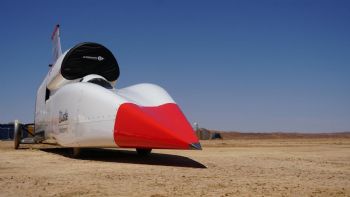
The Bloodhound Land Speed Record (LSR) team today revealed the car aiming to claim a new world land speed record next year — seen for the first time in completed desert spec as it begins its high-speed testing programme in the Hakskeenpan desert in South Africa.
It’s the first time the car has been seen with its precision machined solid aluminium wheels, made specially to withstand the stresses of traveling at supersonic speeds.
For this first test session, the wheels will be tested up to 500+ mph (800 km/h).
The high speed tests will see the Bloodhound LSR car blasting along the Hakskeenpan desert racetrack for the very first time, providing a spectacular showcase of British engineering to a global audience.
The Bloodhound team’s primary objective is to engage and inspire people of all ages through the most extreme application of science, technology, engineering and mathematics.
The world’s fastest straight-line car, powered by a state-of-the-art EJ200 Eurofighter Typhoon jet engine, was rolled out at the Bloodhound Technical Camp and presented to Honourable Premier Dr Zamani Saul of the Northern Cape Provincial Government.
One of the key objectives of the high speed testing programme is, counter-intuitively, to evaluate how the car behaves when slowing down and stopping from a number of target speeds, building up to and beyond 500mph.
Only once engineers and driver Andy Green are satisfied they understand the drag and stopping ability of the car will they push to the next run profile, building speed in each run by increments of 50mph.
The Bloodhound LSR team will examine how much drag the car creates in a number of scenarios and at various speeds, using the wheel brakes, one or both of the drag parachutes, and with the giant airbrakes locked into position.
Data from 192 pressure sensors on the car will be monitored and compared against the predicted CFD (computational fluid dynamic) models to ensure they marry up.
Bloodhound’s engineers will be working with assistant professor Ben Evans and Jack Townsend, from Swansea University, to check the data, which will reveal the amount of drag experienced by the car on each run.
This data is critical to determine the size of the rocket that will be fitted to the car for the attempt to set a new world land speed record in 12-18 months’ time.
Mark Chapman, Bloodhound LSR engineering director, said: “Newquay was all about getting up to speed and finding out how quickly we could get the engine to full power and accelerate using maximum re-heat.
“Andy was on the throttle for two seconds to reach 200mph in 8sec.
“Here at the Hakskeenpan on a 10-mile track we can accelerate for much longer, achieve higher speeds and investigate the car’s stability, performance and drag, all crucial as we move towards setting a new world land speed record.”